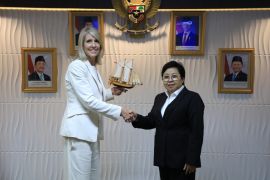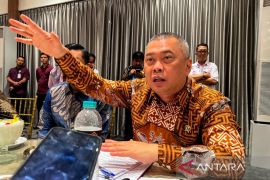PARIS, June 27 (ANTARA/PRNewswire-AsiaNet) --
Sanofi (EURONEXT: SAN and NYSE: SNY) announced today, at the 71st Scientific American Diabetes Association Sessions 2011, the results of three studies showing that people with diabetes using Sanofi insulins Lantus(R) and/or Apidra(R) with the insulin delivery device SoloSTAR(R) experienced greater treatment satisfaction, better quality of life and lower fear of hypoglycemia vs those using a premixed insulin product.
The goal of the first study[1], involving 586 patients with uncontrolled type 2 diabetes on oral agents, was to evaluate any changes in physical and psychological well-being, diabetes-related symptoms, and patient satisfaction with diabetes-related care and treatment over the study period and from baseline to endpoint.
It showed that, compared with those on twice-daily premixed 70/30 insulin aspart (premix), patients on the combination of Lantus(R)- and Apidra(R)-based regimens experienced better quality of life as measured by the Diabetes Quality of Life (DQoL) questionnaire, which evaluates personal perception of improvements as a result of treatment:
- DQoL improved significantly for all groups at all wks; average improvement was greater for basal Lantus(R) (insulin glargine) + 1 prandial Apidra(R) (insulin glulisine) dose (GLARG+1) and stepwise addition of prandial glulisine (GLARG+0-3) vs premix (P=0.0002)
- Compared to the glargine group, patients on premix also showed significantly greater hypoglycemic fear from week 12 to study end (P<0.05).
The goal of the second study[2], conducted with 220 type 1 and type 2 patients from 32 sites in Canada, was to evaluate the change in diabetes treatment satisfaction in people treated with insulin glargine. It showed that 96% of patients experienced significant treatment satisfaction upon switching to Lantus(R) SoloSTAR(R) from their previous treatment: Diabetes Treatment Satisfaction Questionnaire at 6 months = 12.0 (SD = 5.4), compared to overall satisfaction at baseline.
The objective of the third study, LANSOLEAP[3], involving 143 adults with either type 1 or type 2 diabetes in Mexico, was to evaluate satisfaction with the SoloSTAR(R) insulin pen by adult patients. It showed that:
- 83% rated SoloSTAR(R) as excellent
- 78% found SoloSTAR(R) easier to use overall, compared with their previous device
- 87% preferred SoloSTAR(R) to their previous device
- Of those who had never used a pen device, 83% felt confident about using SoloSTAR(R) on the same day they received the pen.
Patient satisfaction is key to improving compliance, and therefore treatment outcomes. As a patient-centric company focused on the needs of people with diabetes Sanofi is committed to improving treatment satisfaction and quality of life.
Notes to editors
About the studies
Polonsky et al (referred as the first study) was a 60-week randomized, open-label study compared adding BID premixed 70/30 insulin aspart (PREMIX), basal insulin glargine + 1 prandial insulin glulisine dose (GLARG+1), or stepwise addition of prandial glulisine (GLARG+0-3) in 586 patients with uncontrolled type 2 diabetes on oral agents. The objective was to evaluate any within- and between-group changes in 1) physical and psychological well-being, 2) diabetes-related symptoms, and 3) patient satisfaction with diabetes-related care and treatment over the study period and from baseline to endpoint. While achieving similar glycemic control and body weight changes, GLARG+1 and GLARG+0-3 were more effective than PREMIX in FBG reduction and reaching A1C <7%, while causing less overall hypoglycemia. Patient reported outcomes were measured at baseline, 6, 12, 24, 36, 48, and 60 weeks to assess overall quality of life, diabetes-specific quality of life (DQoL), hypoglycemic fear and adjustment to illness.
Garon et al (referred as the second study) evaluated the change in diabetes treatment satisfaction in 220 patients with type 1 or type 2 diabetes treated with Lantus(R) SoloSTAR(R). This 6-month Canadian, observational, multicenter, prospective registry collected data in 220 T1&T2 Diabetes patients from 32 sites treated with any combination of unmixed basal insulin, oral anti-hyperglycemic drugs or short-acting insulins who had HbA1c > 7% or HbA1c = 7% with severe or frequent symptomatic hypoglycemia were enrolled in the study. Treatment satisfaction was measured by using the standard Diabetes Treatment Satisfaction Questionnaire at baseline (DTSQs) and after 6 months (DTSQc). Patients acceptance of SoloSTAR(R) pen was assessed using 8-item pen use questionnaire having scores from 1=excellent to 5=very poor. 56 T1DM and 164 T2DM pts were on average 39.7 (SD=12.4) and 59.3 (SD=11.0) years old and had BMIs of 26.9 (SD=4.7) and 33.4 (SD=8.0) kg/m2, respectively.
LANSOLEAP (referred as the third study) was a multicenter, prospective, one-arm, six to eight week observational study, involving adults with either type 1 or type 2 diabetes (who were either insulin users, or insulin naive and taking oral medications and candidates for insulin therapy). The primary objective was to evaluate satisfaction with SoloSTAR(R), evaluated by a self-assessment questionnaire pertaining to overall acceptance (rating of SoloSTAR(R)) and ease and continuation of use. In a second questionnaire, insulin users assessed their preference for SoloSTAR(R) compared with their previous device.
A total of 206 patients were enrolled, with 56 excluded for failing to meet the minimum time of 30 days between visits. The mean age of the 150 patients whose data could be analyzed was 53.3 years (range 18-90 yrs); 58.7% were female, 86.6% had type 2 diabetes, 68% had a BMI >25, and 70% had used insulin previously. The 7 patients who did not inject insulin themselves were excluded from the satisfaction evaluation.
About Lantus[(R)]
Lantus(R) (insulin glargine) is the first 24-hour once-daily basal insulin analog. Lantus(R) is as effective as NPH insulin with similar reductions in HbA1c, but is associated with lower fasting blood glucose concentrations. People with Type 2 diabetes experience a consistent and significant reduction in the incidence of nocturnal hypoglycemia with Lantus(R).[4]
About Apidra[(R)]
Apidra(R) is a fast-acting insulin analog of human insulin with a zinc-free molecular structure that maintains a rapid onset and a short duration of action, indicated for the treatment of adults with type 1 and type 2 diabetes. Apidra(R) offers mealtime dosing flexibility - it can be taken 15 minutes before or within 20 minutes after starting a meal, and in a variety of body types, from lean to obese.
About SoloSTAR(R)
SoloSTAR(R) is Sanofi's prefilled, multi-purpose, disposable insulin pen for the administration of Lantus(R), Apidra(R) and Insuman(R). SoloSTAR[(R)]is the winner of a GOOD DESIGNâ„¢ Award.
About the Sanofi Diabetes Division
Sanofi strives to help people manage the complex challenges of diabetes by delivering innovative, integrated and personalized solutions. Driven by valuable insight that comes from listening to and engaging with people living with diabetes, the Company is forming partnerships to offer diagnostics, therapies, services, and devices. Sanofi markets both injectable and oral medications for people with type 1 or type 2 diabetes. Investigational compounds in the pipeline include an injectable GLP-1 agonist being studied as a single agent, in combination with basal insulins, and/or in combination with oral antidiabetic agents.
About Sanofi
Sanofi, a global and diversified healthcare leader, discovers, develops and distributes therapeutic solutions focused on patients' needs. Sanofi has core strengths in the field of healthcare with seven growth platforms: diabetes solutions, human vaccines, innovative drugs, rare diseases, consumer healthcare, emerging markets and animal health. Sanofi is listed in Paris (EURONEXT: SAN) and in New York (NYSE: SNY).
References
1. Polonksy et al. Patient Reported Outcomes Using Twice-Daily Insulin Aspart Premixed vs Insulin Glargine Plus 1 Prandial Insulin Glulisine or Stepwise Addition of Glulisine to Glargine in Type 2 Diabetes Uncontrolled With Oral Agents (2316-PO) ADA 2011
2. Garon et al. SignificantImprovement in Treatment Satisfaction for Patients (pts) With Type 1 and Type 2 Diabetes Mellitus (T1&T2DM) After 6 Months Following the Initiation of Insulin Glargine (Lantus SoloSTAR(R))( 2223-PO) ADA 2011
3. Arellano SM, Campuzano RR, Santoyo JC, Mauricio GL. Patient Satisfaction with the SoloSTAR(R) Insulin Pen Device in Medical Practice in Mexico: The LANSOLEAP Study (2218-PO) ADA 2011
4. Wang F [http://www.ncbi.nlm.nih.gov/pubmed?term=%22Wang%20F%22%5BAuthor%5D ] et al. Insulin glargine: a systematic review of a long-acting insulin analogue. Clin Ther 2003 25:1541-77
Forward Looking Statements
This press release contains forward-looking statements as defined in the Private Securities Litigation Reform Act of 1995, as amended. Forward-looking statements are statements that are not historical facts. These statements include projections and estimates and their underlying assumptions, statements regarding plans, objectives, intentions and expectations with respect to future financial results, events, operations, services, product development and potential, and statements regarding future performance. Forward-looking statements are generally identified by the words "expects", "anticipates", "believes", "intends", "estimates", "plans" and similar expressions. Although Sanofi's management believes that the expectations reflected in such forward-looking statements are reasonable, investors are cautioned that forward-looking information and statements are subject to various risks and uncertainties, many of which are difficult to predict and generally beyond the control of Sanofi, that could cause actual results and developments to differ materially from those expressed in, or implied or projected by, the forward-looking information and statements. These risks and uncertainties include among other things, the uncertainties inherent in research and development, future clinical data and analysis, including post marketing, decisions by regulatory authorities, such as the FDA or the EMA, regarding whether and when to approve any drug, device or biological application that may be filed for any such product candidates as well as their decisions regarding labeling and other matters that could affect the availability or commercial potential of such products candidates, the absence of guarantee that the products candidates if approved will be commercially successful, the future approval and commercial success of therapeutic alternatives, the Group's ability to benefit from external growth opportunities as well as those discussed or identified in the public filings with the SEC and the AMF made by Sanofi, including those listed under "Risk Factors" and "Cautionary Statement Regarding Forward-Looking Statements" in Sanofi's annual report on Form 20-F for the year ended December 31, 2010. Other than as required by applicable law, Sanofi does not undertake any obligation to update or revise any forward-looking information or statements.
SOURCE: Sanofi
Editor: PR Wire
Copyright © ANTARA 2011










